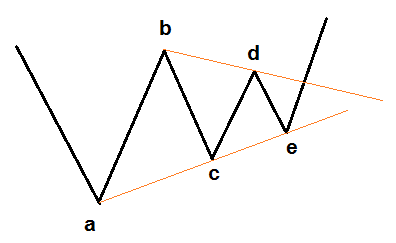Despite the general belief, markets spend most of the time in consolidation. This is valid for the Forex market too, even though spikes or violent dips give the impression that the market is moving. In reality, the market is just consolidating on the bigger time frames.
Consider the Asian session. How many times did you see the Forex market moving aggressively in this session? How many times did you see the market in overbought or oversold levels in this market? Rarely this is happening, and this is because ranges happen most of the times. It is said that the markets spend more than 60% of the time in ranges or in consolidation. Depending on the currency pair traded, the percentage can be bigger.
The favorite way for the market to consolidate is to form a triangle. Triangular formations are everywhere. There are many types of triangles that can form, but the most popular one, or the one that appears most of the times, is a contracting triangle.
A contracting triangle must contract. The contracting nature is given by the aspect of its trend lines. As a rule of thumb, a triangle has two trend lines: the a-c and b-d trend lines. These are the result of connected the end of the first four legs of the triangle. Moreover, a triangle has five segments, no more, no less, and they are always labeled with letters: a-b-c-d-e.
 This is why, connecting the a-c and b-d points, the two trend lines are definitory for a triangle. In order for them to contract, it means that they must intersect somewhere on the right side of the chart. In reality, as long as they are not parallel, but suggest contraction, it is a valid setup for a contracting triangle.
This is why, connecting the a-c and b-d points, the two trend lines are definitory for a triangle. In order for them to contract, it means that they must intersect somewhere on the right side of the chart. In reality, as long as they are not parallel, but suggest contraction, it is a valid setup for a contracting triangle.
A contracting triangle has various shapes. The most common type is called a horizontal contracting triangle. In this case, all the legs of the triangle are smaller than the previous one. This makes the first leg, the a-wave, to be the longest, and the rest to be shorter than the previous leg. The shape of such a triangle is looking like this: a>b>c>d>e.
The next possible representation for a contracting triangle is when the b-wave is the longest wave. All other criteria from the previous type are valid, with the simple exception that the b-wave is the longest wave. Therefore, b>a, but c<b, d<c and e<d. This triangle is called an irregular triangle and the name of it comes from the irregularity showed by the b-wave.
Another type of a triangle is the running one. This is quite a rare formation, but it forms on the Forex market. It is not possible to have such a triangle as an individual pattern, unless if it is the 4th or the b-wave in the Elliott Waves theory. As a side note, the Elliott Waves theory is all about triangles and triangles interpretation.
No matter the type of the contracting triangle, the way to trade it is to measure the length of its longest wave, and then simply find the fifty percent retracement level. This can be done using the Fibonacci retracement tool, or any other tool that gives retracement levels. If the triangle forms during a bullish trend, the ideas is to buy any pullback below the 50% retracement level, for a break of the b-d trend line. If it is part of a bearish break, the idea is to sell any spike above the 50% level, for a break of the b-d trend line. In any case, the b-d trend line is the most important one. Traders look for its break as a sign that the triangle or the consolidation ended, and the previous trend resumes.
Triangle formations should be part of any forex trading for beginners course. They are powerful patterns that form often and give an idea about future prices to come. After all, trading is a pattern recognition approach that allows forecasting future prices.
